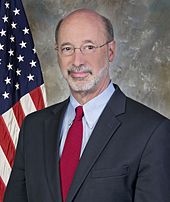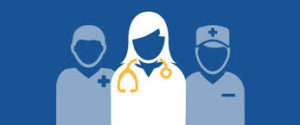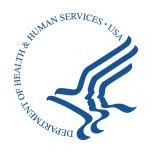The following is the latest COVID-19 information from Pennsylvania’s state government (as of 3:30 on Tuesday, September 22) and the federal government (as of 2:45 p.m. on Monday, September 21).
Pennsylvania Update
Governor Wolf
 Governor Wolf and Health Secretary Levine introduced “COVID-19 Alert PA,” a new cell phone app that the state hopes will facilitate contact tracing. The app, which works on Android and Apple cell phones, uses bluetooth technology to identify people who were recently near someone who has been diagnosed with COVID-19. The app notifies individuals who may have been exposed and directs them to resources but does not provide the name of the person who was diagnosed and does not provide the state with the names of people who may have been exposed, protecting the privacy of everyone involved and leaving responsibility to act at the discretion of the people with the app on their phone. The app, which is free, does not track people and their location. Learn more from this news release.
Governor Wolf and Health Secretary Levine introduced “COVID-19 Alert PA,” a new cell phone app that the state hopes will facilitate contact tracing. The app, which works on Android and Apple cell phones, uses bluetooth technology to identify people who were recently near someone who has been diagnosed with COVID-19. The app notifies individuals who may have been exposed and directs them to resources but does not provide the name of the person who was diagnosed and does not provide the state with the names of people who may have been exposed, protecting the privacy of everyone involved and leaving responsibility to act at the discretion of the people with the app on their phone. The app, which is free, does not track people and their location. Learn more from this news release.
Department of Health
The Department of Health answered several provider questions in its COVID-19 Guidance Wrap-up document related to recommendations for eye protection, data sources for county positivity rates, and skilled nursing facility data reporting.
The Department of Health issued a new health alert on Testing and Management Guidance for Patients After Exposure to SARS-CoV-2, recommending testing for asymptomatic persons who were in close contact with someone who tested positive for COVID-19.
The Department of Health announced that Walmart is closing its remaining nine drive-through parking lot COVID-19 testing sites on September 26.
 Department of Health – by the numbers
Department of Health – by the numbers
- This week’s joint news release from Governor Wolf and the Department of Health revealed that during the week of September 11 to September 17 the number of new COVID-19 cases rose 10.5 percent but the state-wide rate of positive tests fell from 4.2 percent to 3.8 percent.
- Counties with especially high positivity rates are Centre (12.1 percent), Indiana (11.6) and York (7.8 percent).
- On a day-to-day basis the number of new COVID-19 cases continues to fluctuate considerably.
- The continued high numbers are driven in large part by major increases in the number of young people between the ages of 19 and 24 who are contracting COVID-19. Eight percent of all cases of COVID-19 among children between the ages of five and 18 occurred between September 11 and September 27.
- The number of Pennsylvanians currently hospitalized with COVID-19 and the number of such patients breathing with the help of a ventilator continue to decline slowly.
- More than 10,400 health care workers in the state have contracted COVID-19.
- 21 percent of the beds in Pennsylvania’s acute-care hospitals are currently unoccupied, as are 24 percent of adult ICU beds, 16 percent of pediatric ICU beds, 37 percent of pediatric beds, and 40 percent of airborne isolation rooms.
Department of Human Services
DHS has updated its guidance on COVID-19 for personal care homes, assisted living residences, and private intermediate-care facilities.
Federal Update (as of Monday, September 21)
Provider Relief Fund Reporting Requirements
 HHS has updated its Provider Relief Fund web page with the document “General and Targeted Distribution: Post-Payment Notice of Reporting Requirements.” The purpose of this document is to inform recipients of Provider Relief Fund payments that received one or more payments exceeding $10,000 in the aggregate of the data elements they will be required to report as part of the post-payment reporting process. This is important because it identifies how HHS will calculate lost revenue and COVID-related expenses for both general distribution and targeted Provider Relief payments for reporting requirements.
HHS has updated its Provider Relief Fund web page with the document “General and Targeted Distribution: Post-Payment Notice of Reporting Requirements.” The purpose of this document is to inform recipients of Provider Relief Fund payments that received one or more payments exceeding $10,000 in the aggregate of the data elements they will be required to report as part of the post-payment reporting process. This is important because it identifies how HHS will calculate lost revenue and COVID-related expenses for both general distribution and targeted Provider Relief payments for reporting requirements.
A key passage in this document, on page 1 under “Reporting Guidance on Use of Funds,” states that “Recipients will report their use of PRF [Provider Relief Fund] payments by submitting the following information:”
Healthcare related expenses attributable to coronavirus that another source has not reimbursed and is not obligated to reimburse, which may include General and Administrative (G&A) or healthcare related operating expenses (further defined within the data elements section below).
PRF payment amounts not fully expended on healthcare related expenses attributable to coronavirus are then applied to lost revenues, represented as a negative change in year-over-year net patient care operating income (i.e., patient care revenue less patient care related expenses for the Reporting Entity, defined below, that received funding), net of the healthcare related expenses attributable to coronavirus 2 calculated under step 1. Recipients may apply PRF payments toward lost revenue, up to the amount of their 2019 net gain from healthcare related sources. Recipients that reported negative net operating income from patient care in 2019 may apply PRF amounts to lost revenues up to a net zero gain/loss in 2020.
If recipients do not expend PRF funds in full by the end of calendar year 2020, they will have an additional six months in which to use remaining amounts toward expenses attributable to coronavirus but not reimbursed by other sources, or to apply toward lost revenues in an amount not to exceed the 2019 net gain. For example, the reporting period January – June 2021 will be compared to the same period in 2019.
Providers should review the entire document “General and Targeted Distributions: Post-Payment Notice of Reporting Requirements” very carefully.
In addition, HHS has updated its Provider Relief Fund web page with the following notice:
In accordance with the Office of Management and Budget’s Memorandum M-20-21, all financial information that agencies are required to report concerning their disposition of CARES Act and other supplemental COVID-19 appropriated funds is publicly available on USAspending.gov. View the COVID-19 Spending profile page.
Medicare Accelerated and Advance Payment Program
- In an interview with Modern Healthcare, CMS Administrator Seema Verma confirmed that the federal government is delaying recoupment of the Medicare revenue provided to hospitals through the CARES Act’s Accelerated and Advance Payment Program to help them weather the onslaught of COVID-19 and the loss of revenue they anticipated because of their temporary need to suspend non-urgent procedures during the early months of the pandemic. The original plan was for CMS to withhold 100 percent of Medicare payments to hospitals beginning in August until the money advanced to them was repaid, but that withholding has now been put off for an unspecified period of time. Find the interview with Administrator Verma (by subscription only) here.
- The House has released a draft bill for a continuing resolution to fund the federal government when the 2021 fiscal year begins on October 1 through December 11. That bill addresses the same Accelerated and Advance Payment Program. Its highlights include:
- For the first 11 months during which a provider is repaying, the recoupment may be up to 25 percent of what Medicare would otherwise be paying that provider for items and services provided.
- For the next six months the offset may be up to 50 percent of what Medicare would be paying that provider.
- Providers have 29 months from the date the first accelerated payment was made to repay the amount in full.
- The interest on accelerated and advance payments only appears to begin 30 days after the 29-month period at four percent. Under the CARES Act, the interest rate is around 10 percent.
- The continuing resolution would establish a $10 million cap a year for future advance payments to Medicare Part B providers.
- CMS is given two weeks to publish a list of providers that received these payments on a public website.
- Learn more from this House summary of the bill or go here to see the bill itself.
Department of Health and Human Services
 HHS has issued a memo on agency procedures clarifying that all department rules, which are all issued by the Secretary, must now be signed by the Secretary.
HHS has issued a memo on agency procedures clarifying that all department rules, which are all issued by the Secretary, must now be signed by the Secretary.
The department released the following statement on this action:
Before and after this action, no regulation issues from any part of HHS without the approval of the Secretary and the White House. The only change made by this memo is that, instead of the Secretary’s just approving all agency regulations, each regulation now also will be formally signed by him. Any speculation about this memo being motivated by policy considerations is utterly misinformed. This good-government action is only prospective in effect and minimizes litigation risk for the department’s public health actions, prevents potential future abuse of authority, and is consistent with congressional intent. The memo should have no effect on operational work and does not pertain in any way to guidance or any vaccine or drug approval or authorization. This action will not slow any HHS agencies’ work. It is simply the ministerial, administrative act of attaching a signature to a document.
- HHS’s Office of the Inspector General has updated its calendar of inspections, audits, and evaluations on COVID-19-related matters.
Centers for Medicare & Medicaid Services
CMS has posted new information on Medicare payment for COVID-19 testing in nursing facilities based on whether the payer is Medicare, Medicaid, the Provider Relief Fund, the Centers for Disease Control and Prevention, or private insurance. The information includes a summary of clinical laboratory fee schedule codes.
CMS COVID-19 Stakeholder Calls
CMS hosts recurring stakeholder engagement sessions to share information related to its response to COVID-19. These sessions are open to members of the health care community and are intended to provide updates, share best practices among peers, and offer attendees an opportunity to ask questions of CMS and other subject matter experts.
CMS COVID-19 Office Hours Call
Tuesday, September 22 at 5:00 – 6:00 PM Eastern
Toll-free attendee dial-in: 833-614-0820; Access Passcode: 2409459
To join call, go here.
Home Health and Hospice Call
Tuesday, September 22 at 3:00 – 3:30 PM Eastern
Toll-free attendee dial-in: 833-614-0820; Access Passcode: 1169237
To join call, go here.
 Dialysis Organizations Call
Dialysis Organizations Call
Wednesday, September 23 at 5:30 – 6:00 PM Eastern
Toll-free attendee dial-in: 833-614-0820; Access Passcode: 7026727
To join call, go here.
Nurses Call
Thursday, September 24 at 3:00 – 3:30 PM Eastern
Toll-free attendee dial-in: 833-614-0820; Access Passcode: 5872398
To join call, go here.
Conference lines are limited, so CMS encourages interested parties to join via audio webcast. To listen to the audio files and read the transcripts for these and past COVID-19 Stakeholder calls, visit CMS’s Podcast and Transcripts page.
Food and Drug Administration
- The FDA has updated its guidance on the use of convalescent plasma in the treatment of patients with COVID-19. The update, introduced by regulation, withdraws previous guidance and provides updated guidance that
… includes a discussion to facilitate the availability of investigational convalescent plasma when blood establishments, hospitals, and healthcare providers collect plasma that does not meet the Conditions of Authorization of the Emergency Use Authorization (EUA).
- The FDA has approved an abbreviated new drug application for propofol injectable emulsion for single patient use only. Propofol injectable emulsion is an intravenous general anesthetic and sedation drug that can be used to sedate patients undergoing intubation for treatment of COVID-19.
Centers for Disease Control and Prevention
- The CDC has updated its guidance on when individuals should be tested for COVID-19. The updated guidance states that “Due to the significance of asymptomatic and pre-symptomatic transmission, this guidance further reinforces the need to test asymptomatic persons, including close contacts of a person with documented SARS-CoV-2 infection.” This essentially reverses CDC guidance issued in August.
- The CDC has updated its interim laboratory biosafety guidelines for handling and processing specimens associated with COVID-19.
Government Accountability Office
- The GAO has published a new report on its oversight of federal actions to support public health, individuals, and the economy during the COVID-19 pandemic. Go here to see “COVID-19: Federal Efforts Could Be Strengthened by Timely and Concerted Actions.”
Resources to Consult
Pennsylvania Department of Human Services
Pennsylvania Department of Health
Centers for Disease Control and Prevention